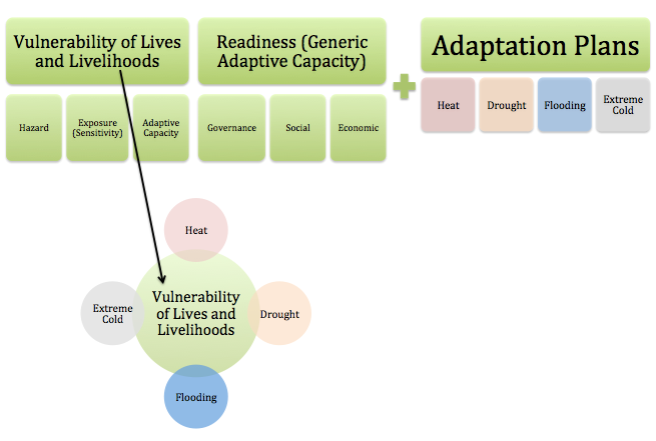Meghan Doherty
Notre Dame Global Adaptation Index (ND-GAIN), USA

It’s a new era for climate adaptation: Four out of the five most concerning global risks for the next 10 years are directly linked to the need to adapt to the changing climate (World Economic Forum, 2016). Though these are global problems often discussed at the national scale, urban areas are increasingly seen as having a critical role in the adaptation agenda. The 21st session of the Conference of the Parties (COP 21) highlighted the need to establish a global goal on adaptation of “enhancing adaptive capacity, strengthening resilience and reducing vulnerability to climate change.” In addition, the agreement calls out cities as relevant actors by acknowledging the need for non-Party stakeholders “to address and respond to climate change” (UNFCCC, 2015).
COP 21 highlighted cities for good reason; as of 2014, 81 percent of the US population (and more than 50 percent worldwide) currently resides in cities. Vast urbanization is expected to continue and by 2050, the world “will be one third rural (34 per cent) and two-thirds urban (66 per cent)” (United Nations et al., 2014). While mitigation is thought of as a global issue, adaptation is inherently local; when extreme weather events happen, they are local problems that require local solutions. In 2014 alone, climate events resulted in the deaths of over 8,000 people as well as about 90.86 billion USD in total economic damage (International Disaster Database, 2015), most of which was incurred by cities.

But even in this new era, decision-makers face significant challenges including: uncertainty of urban climate hazards, lack of data to understand and track urban vulnerability to climate change, lack of measurement to prioritize adaptation actions, and difficulty integrating adaptation information into current procedures. This makes it difficult for decision-makers to prioritize resource allocations in a milieu of competing priorities. From City Council members to Chambers of Commerce to Civil Servants, without the means to measure adaptation risks, gaps and progress, cities are challenged to get ahead of their climate risks and make decisions to save lives and improve livelihoods.
Responding to the need for measurement to inform the increased demand for urban resilience and effective adaptation prioritization, the Urban Adaptation Assessment (UAA) project, funded by the Kresge Foundation and led by the Notre Dame Global Adaptation Index (ND-GAIN) in collaboration with a robust advisory committee, provides a solution by building an assessment, piloting it in 5 U.S. cities and ultimately scaling it around the world. Government, non-profit and business leaders will use the local-scale assessment to inform and prioritize market and policy positions around social, physical, and natural systems, making them resilient to the impacts of climate change.

In line with ND-GAIN’s mission “to enhance the world’s understanding of adaptation through knowledge, products and services that inform public and private actions and investments in vulnerable communities,” one of the intended outputs from the UAA pilot assessment is consensus on a measurement framework and set of indicators. This framework will both increase understanding of adaptation and elevate critical needs for adaptation actions in urban areas.
To establish the Urban Adaptation Assessment (UAA) framework and indicator list, ND-GAIN created an advisory committee made up of U.S. and international adaptation influencers. Advisors shared feedback on framework components and reviewed a straw man list of indicators, created based on a literature review and experience with ND-GAIN’s Country Index. They also suggested additional and alternative indicators at in person group meetings and on bi-lateral phone calls. UAA evaluated the resulting list of indicators with additional literature reviews and consideration of data availability. Throughout the process, over 100 indicators were evaluated. This Advisor engagement resulted in the following unique elements included in the UAA framework:
Including lives and livelihoods as the focal point of a hazard-based approach
Instead of the vulnerability aspect of the framework analyzing the effect of climate change on relevant urban sectors (food, water, health, ecosystem services, human habitat, and infrastructure), the UAA focuses on vulnerability in terms of four climate hazards (extreme cold, extreme heat, drought, and flooding) and their effect on the human population. This human focus is important at the city scale, because city officials act on behalf of their constituents, corporations rely on their employees and their consumers, and advocates seek assets for their interested populations.
Allowing users to customize the assessment for two possible climate futures
As the framework takes a hazard-based approach to vulnerability, it was beneficial to include the option for decision-makers to understand their climate risks in terms of two possible climate futures. These two futures, exemplified by representative concentration pathways (RCP) 4.5 and 8.5, depend on the extent of future greenhouse gas emissions. Users are able to understand their vulnerability under both a RCP4.5 and an 8.5 scenario and therefore be better prepared for the variable effects of future climate change.
Using a statistical approach to identify the most relevant, actionable indicators
The assessment’s indicators are expected to have explanatory power on why urban areas have experienced a certain level of adverse impacts from historical climate hazards. A selection model was built to look for those indicators that co-vary with outcome data that city decision-makers are concerned with; the resulting fatalities, injuries and property damage from climate hazards. This approach allows UAA indicators to better represent actions most related to reducing the outcomes cities want to avoid.
Assessing existing adaptation plan materials
ND-GAIN defines adaptation plan materials as plans made by city government to proactively or reactively respond to the impact of climate stresses. These plans help identify where cities have already prioritized their adaptation resources. In UAA, adaptation plans will be qualitatively assessed to review actions taken to reduce sensitivity or improve adaptive capacity in light of that area’s vulnerability. Assessing adaptation plans is important for stakeholders as it may reflect the development of adaptive capacity over time and will help to carry out UAA’s intent to motivate government, corporations and communities to build social, physical, and natural systems that are resilient to the impacts of climate change.
Creating a framework that includes a vulnerability and readiness component
Through collaboration with its advisory committee, ND-GAIN developed the following framework for its Urban Adaptation Assessment:
UAA’s framework is broadly grouped in terms of the city’s vulnerability and its readiness to adapt. Vulnerability is understood in terms of the impact four primary hazards (extreme heat, drought, extreme cold, and flooding) on the lives and livelihoods of the urban population. It is assessed through indicators capturing the probability and magnitude of the hazards themselves, the extent to which an urban area will be affected by, or responsive to, a climate hazard (“sensitivity”) and the ability of an urban area to prepare for or cope with the exposed and sensitive stresses (“adaptive capacity”). Readiness is understood in terms of the economic, social, and governance characteristics of an urban area. The unique readiness component is particularly helpful to highlight other priority areas for cities that may have co-benefits with their overall adaptability to climate change.

Piloting the assessment
With a set of indicators derived through careful consultation with experts and analyzed through statistical methods, a focus on human impacts, a means to customize by possible climate futures, and a consideration of cities’ adaptation plans, the Urban Adaptation Assessment will be piloted in five US cities (Baltimore, Davenport, Los Angeles, Memphis, and Seattle). The results will be used to modify and improve the overall framework, ultimately creating a standard for city adaptation measurement that can be used to help prioritize adaptation actions in cities around the world.
Those interested in additional materials should reference the publicly accessible Adaptation Collaboratory created for the project.

Meghan Doherty is the Project Manager for ND-GAIN’s Urban Adaptation Assessment.
Website
Email
Header Image: Memphis, Tennessee. Image credit: OFFFSTOCK / shutterstock.com
